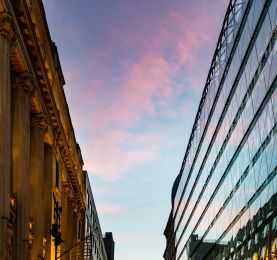Faced with increasing disturbance from changing weather patterns and with the risk of advancing damage to our planet as a result of rising greenhouse gases, governments, companies and associations are taking crucial steps to reduce emissions and ultimately become carbon neutral.
The European Green Deal is one example of the European Union’s commitment to a climate-neutral continent. The aim of this deal is to have no net emissions of greenhouse gases by 2050 and to reduce net greenhouse gas emissions by at least 55% by 2030, compared to 1990 levels . The purpose of the European Green Deal is to improve the well-being and health of citizens across Europe, as well as that of future generations. To do this, the deal seeks to encourage the renovation and energy efficiency of buildings, to increase public transport and focus on cleaner energy and technological innovation.
Along with the COP26 in Glasgow, which made stronger commitments to the reduction of using coal and the adoption of the Glasgow Climate Pact, which adopts a more ambitious climate response, the topic of how to reduce carbon emissions is unavoidable.
For BNP Paribas Real Estate, in each of our activities we are focused on working towards net-zero ambitions, which is why we are part of different initiatives, programmes and events, including the Forum Zéro Carbone. Working in a sustainable and environmentally aware way is something which we are focused on within the BNP Paribas group and at BNP Paribas Real Estate. At BNP Paribas Real Estate, in each of our activities we work to uphold these net-zero commitments and continually strive to understand what new actions we can put in place.
Employing low carbon solutions across BNP Paribas Real Estate
Across BNP Paribas Real Estate, which includes Property Development, Property Management and Transaction, we are able to show very concrete and clear examples of our net-zero commitments. This applies to our engagement for the transformation of metropolises, as we work to create a truly sustainable city.
For example, how we conceive a building, through to how it is built, managed and run are carefully considered, as we question how each parts of the building’s lifecycle can respond to a low-emissions city. This thought process is applied to all types of buildings; urban projects, residential and workspaces. We also think in great detail about how each of these actions can be applied on a long-term basis, meaning how the building is integrated into its environment and the city as a whole, and how it will continue to be attractive in years to come. The Senckenberg Tower in Frankfurt is one such building. Built with a link to the Schwanheimer dune, a 60-hectare nature reserve a few minutes from the airport, the Senckenberg Tower is an example of how to integrate local biodiversity into a building. This helps to reduce its carbon footprint and creates a long-lasting relationship between the building and its environment.

Property development made-to-measure
The cities of tomorrow are being built all around us today. They are smarter, sustainable, innovative and tailored to our ever-evolving ways of life.
Capitalising on natural and historical elements
Ensuring that buildings and their surroundings are environmentally focused is possible through the choice of materials. At BNP Paribas Real Estate, we aim to promote sustainable materials, ensuring that they are reclaimed or recycled. By re-using materials, we help ensure that we are not depleting our planet’s natural resources and consuming more energy to make new materials. One example of this is the #Curve building in Nanterre, on the outskirts of Paris. This new-generation building is built in wood, and is innovative in its bioclimatic construction method, which significantly reduces greenhouses gas emissions compared to traditional construction methods.
What is equally important is the respect we must give to the history of buildings, as we do not want to destroy or chip away at them but instead accentuate them. This means not demolishing existing buildings or reconstructing them, but rather focusing on transforming them in order to give them a new lease of life, all whilst capitalising on their past. Programmes like Horti in Milan, which has transformed three historic buildings into flats and townhouses are ways of preserving the past and showcasing the history of certain structures.
By truly considering a building, its environment, the city which it sits and the mark it will leave, we are able to understand how people interact with it. This is an aspect which we carefully consider in our projects, and as such we accompany those who live or work in buildings in order to understand how they want to use a building. As interactions change over time, we must continually evolve to understand the different needs of those inside buildings. Offering mixed-use buildings is therefore a response to the changing relationship to buildings and the city itself and is therefore an aspect which we promote within our buildings.




